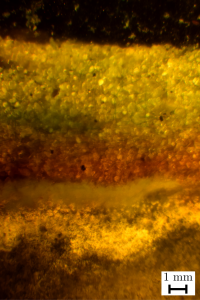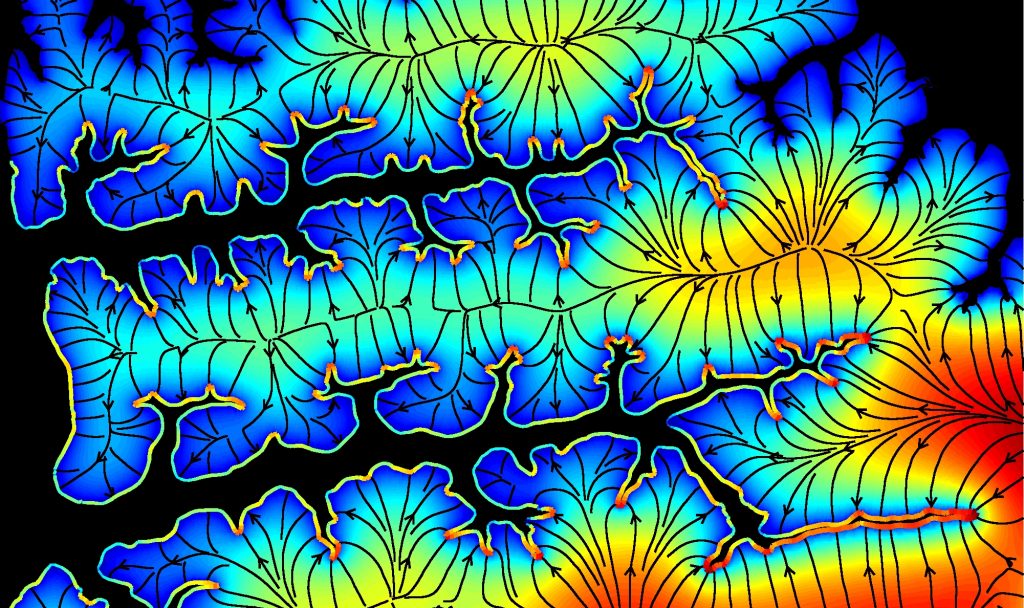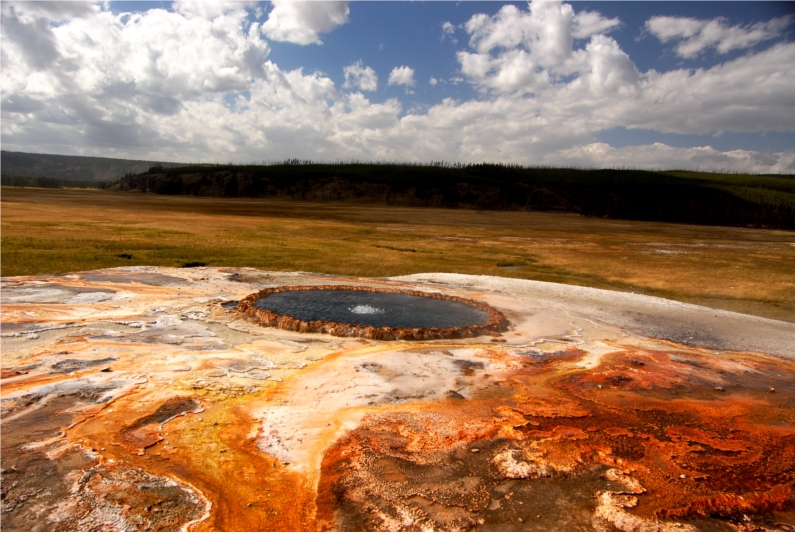Microbial ecosystems in sediment

Current Work I devise simple models and experiment to explain the dynamics of complex microbial ecosystems in natural sediment. Within this porous medium, bacteria are densely packed (109 cells/cm3) and extremely diverse (107genotypes). When light shines on mud, photosynthetic organisms on the surface produce oxygen and sugars. As these nutrients diffuse through the sediment, the resulting free-energy gradient is dissipated by a cascade of microbial interactions. Remarkably, evidence of this cascade is visible to the naked eye in the form of millimeter-scale strata. How does this ecosystem come to a steady state and what can destabilize it? Given an environment, can we predict the behaviors of the organisms within it? What new phenomena can we discover by studying the diverse behaviors of these organisms? I answer these questions in two ways. First, I observe and model how the diffusion and consumption of nutrients from a source cause a complex community to organize into strata. Second, I enrich individual microbes to study the strategies they use to cope with life in a nutrient gradient.
Petroff, AP, Tejera, F, Libchaber, A. Mud, microbes, and oxygen, a three-body problem. Journal of Statistical Physics (in review).
Petroff, AP, Libchaber, A. Localization and dynamics of sulfur-oxidizing microbes in natural sediment. (in prep).
Bacterial crystals
We have discovered a new type of collective motion. T. majus cells self organize into hexagonally-packed rotating crystals of quickly-spinning cells. We showed how this behavior arises from the tornado-like flow of water created by each cell. These crystals show beautiful new dynamics. Crystals rotate, display active surface melting, and can “count” the number of cells in a crystal. One crystal is shown in the video above (each cell is 8 micron in diameter). The discovery of this new state of matter was only possible because we enriched these difficult-to-grow organisms.
Petroff, AP, Wu, XL, Libchaber, A. Fast-moving bacteria self organize into active two-dimensional crystals of rotating cells. Physical Review Letters 114, 158102 (2015)[link]
Dynamics of bacterial cooperation
We have enriched two microbes that create fluid flows to overcome oxygen diffusion limitation, the sulfur-oxidizing bacteria Thiovulum majus and the ciliate Uronemella. In their natural environment, these microorganism have both evolved the ability to form communities to stir the surrounding fluid. We have observed these communities in the lab and modeled their behavior. The video above shows one such community of Uronemella (1 cm across). Cells self-organize to generate dimples (each containing tens of thousands of cells) which pull fluid through the community. By deriving the equations of motion for the cells, we have identified how they use a hydrodynamic instability to spontaneously generate large-scale flows that transport oxygen forty times faster than diffusion. This project has identified the physical basis for the convergent evolution of two phylogenetically disparate microbes.
Petroff A, Libchaber A. Hydrodynamics and collective behavior of the tethered bacterium Thiovulum majus. Proceedings of the National Academy of Sciences 111, E537–E545. (2014).[link]
Petroff, A, Pasulka A, Soplop N, Wu XL, Libchaber A. Biophysical basis for convergent evolution of two veil-forming microbes. Royal Society Open Science 2, 150437 (2015).[link]
Physics of valley growth

Rivers networks are among the most visually striking features on the Earth surface. How water flows into different parts of the network is one of the principal processes that determines network geometry. In general, because water flows down hill, the competition between different branches of a network is strongly coupled to the shape of the surrounding landscape. To simplify this problem, we studied the geometry of stream networks that grow in response to groundwater. We showed that the competition for groundwater around a seepage network in the Florida panhandle is determined entirely by the geometry of the network. Moreover, competition is mathematically simple, the groundwater flow is determined by a solution of the Poisson equation. Using these results, we showed that the geometry of bifurcations, the equilibrium profile of a stream, and the topography around a growing spring can all be understood from first principals. To test these predictions, we made frequent field trips to a natural kilometer-scale seepage network, used observations of enigmatic networks on Mars, and conducted table-top experiments. We found that the predictions of simple models are in good agreement with the observed forms of channels on Earth and Mars and experiments and thus offer fundamental insight into the growth of networks.
Petroff, AP, Devauchelle, O, Seybold H, & Rothman DH Bifurcation dynamics of natural drainage networks. Philosophical Transactions of the Royal Society A 371, 2004 (2013).[link]
Berhanu, M, Petroff, AP, Devauchelle, O, Kudrolli, A, & Rothman, DH. Shape and dynamics of seepage erosion in a horizontal granular bed. Physical Review E 86, 041304 (2013).[link]
Devauchelle, O, Petroff, AP, Seybold H, & Rothman DH. Ramification of Stream Networks. Proceedings of the National Academy of Sciences 109, 20832 (2012).[link]
Petroff, AP, Devauchelle, O, Kurolli A, & Rothman DH. Four bagatelles on channel growth. Comptes Rendus Geoscience344, 33 (2012).[link]
Petroff, AP, Devauchelle, O, Abrams, DM, Lobkovsky, A, Kudrolli, A & Rothman, DH. Geometry of valley growth. Journal of Fluid Mechanics. 273, 245 (2011) [link]
Devauchelle, O, Petroff, AP, Lobkovsky, A & Rothman, DH. Longitudinal profile of channels cut by springs. Journal of Fluid Mechanics. 667, 28 (2011)[link]
Abrams, DM, Lobkovsky, A, Petroff, AP, Straub, K, McElroy, B, Mohrig, D, Kudrolli, A. & Rothman, DH. Growth laws for channel networks incised by groundwater flow. Nature Geoscience , 28, 193-196 (2009)[link]
Microbial fossils

To understand and date the evolution of early metabolisms, including photosynthesis, one must recognize and interpret microbial fossils. This goal is challenging because many of the oldest putative fossils are only identified as biotic by a peculiar shape. One particularly enigmatic class of fossils are millimeter to meter scale laminated structures calledstromatolites that are widely thought to be fossilized microbial mats. In an effort to develop a biological interpretation for these structures, we combined physical insight with observations of modern cyanobacterial mats from laboratory cultures and the field. We showed that growth of a bacterium in some modern stromatolites is limited by the rate at which diffusion transports nutrients from the surrounding water, through the microbial mat, and to the bacterium. Through a combination of physical reasoning, laboratory experiments, and field observations, we have found that one class of of stromatolites arises from the diffusion of ions through a thin microbial mat and the spacing between neighboring stromatolites can record the competition for nutrients.
Petroff, AP, Beukus, N, Rothman, DH, & Bosak, T. Biofilm growth and fossil form. Physical Review X 3, 041012 (2013).[link]
Bosak, T, Knoll, AH, & Petroff, AP. The Meaning of Stromatolites. Annual Review of Earth and Planetary Sciences 41, 21 (2012).[link]
Sim, MS, Liang, B, Petroff, AP, Evans, A, Klepac-Ceraj, V, Flannery, D, Walter, MR, & Bosak, T. Oxygen-Dependent Morphogenesis of Modern Clumped Photosynthetic Mats and Implications for the Archean Stromatolite Record. Geosciences2, 235 (2012).[link]
Petroff, AP, Wu, TD, Liang, B, Mui, J, Guerquin-Kern, JL, Vali, H, Rothman, DH, Bosak, T. Reaction-diffusion model of nutrient uptake in a biofilm: Theory and experiment. Journal of Theoretical Biology 289, 90 (2011).[link]
Petroff, AP, Sim, MS, Maslov, A, Krupenin, M, Rothman, DH, & Bosak, T. Biophysical basis for the geometry of conical stromatolites. Proceedings of the National Academy of Sciences 107, 9956 (2010) [link]
Bosak, T, Bush JWM, Flynn MR, Liang, B, Ono, S, Petroff, AP, & Sim, MS Formation and stability of oxygen-rich bubbles that shape photosynthetic mats. Geobiology , 8, 45–55 (2010).[link]
Bosak, T, Liang, B, Sim, M & Petroff, AP, Rothman DH. Morphological record of oxygenic photosynthesis in conical stromatolites. Proceedings of the National Academy of Sciences 106, 10939 (2009)[link]
Other problems that interest me
- complex systems
- fluid mechanics
- collective dynamics
- ecology
- interface growth
- harmonic fields